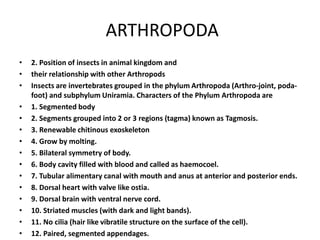
ARTHROPODA MAHENDRA PAL12.pptx
- 1. ARTHROPODA • 2. Position of insects in animal kingdom and • their relationship with other Arthropods • Insects are invertebrates grouped in the phylum Arthropoda (Arthro-joint, poda- foot) and subphylum Uniramia. Characters of the Phylum Arthropoda are • 1. Segmented body • 2. Segments grouped into 2 or 3 regions (tagma) known as Tagmosis. • 3. Renewable chitinous exoskeleton • 4. Grow by molting. • 5. Bilateral symmetry of body. • 6. Body cavity filled with blood and called as haemocoel. • 7. Tubular alimentary canal with mouth and anus at anterior and posterior ends. • 8. Dorsal heart with valve like ostia. • 9. Dorsal brain with ventral nerve cord. • 10. Striated muscles (with dark and light bands). • 11. No cilia (hair like vibratile structure on the surface of the cell). • 12. Paired, segmented appendages.
- 2. PHYLUM ARTHROPODA • Phylum Arthropoda is Classified in to 7 classes. • 1. Onychophora (claw bearing) e.g. Peripatus • 2. Crustacea (Crusta - shell) e.g. Prawn, crab, wood louse • 3. Arachnida (Arachne - spider) e.g. Scorpion, spider, tick, mite • 4. Chilopoda (Chilo - lip; poda - appendage) e.g. Centipedes • 5. Diplopoda (Diplo - two; poda- appendage) e.g. Millipede • 6. Trilobita (an extinct group) • 7. Hexapoda (Hexa- six; poda-legs) or Insecta (In- internal; sect – cut) e.g. Insects.
- 3. INSECT HEAD • 1. Head: First anterior tagma formed by the fusion of six segments namely preantennary, antennary, intercalary, mandibular, maxillary and labial segments. Head is attached or articulated to the thorax through neck or cervix. Head capsule is sclerotized and the head capsule excluding appendages formed by the fusion of several sclerites is known as cranium. • Sclerites of Head • i. Vertex: Summit of the head between compound eyes. • ii. Frons: Facial area below the vertex and above clypeus. • iii. Clypeus: Cranial area below the frons to which labrum is attached. • iv. Gena: Lateral cranial area behind the compound eyes. • v. Occiput : Cranial area between occipital and post occipital suture. • Sutures of Head: The linear invaginations of the exoskeleton between two sclerites are called as suture (some times referred as sulcus).
- 4. INSECT THOREX • 2. Thorax: Second and middle tagma which is three segmented, namely prothorax, mesothorax and metathorax. Meso and metathorax which bear wings are called as Pterothorax. Thoracic segments are made up of three sclerites namely, dorsal body plate tergum or nota, ventral body plate sternum and lateral plate pleuron. • Thoracic nota: Dorsal body plate of each thoracic segments are called as pronotum, mesonotum and metanotum respectively. • Pronotum: This sclerite is undivided and saddle shaped in grasshopper and shield like in cockroach.
- 5. INSECT ABDOMEN • 3. Abdomen: Third and posterior tagma of insect body. This tagma is made up of 9-11 uromeres (segments) and is highly flexible. Abdominal segments are telescopic in nature and are interconnected by a membrane called conjunctiva. Each abdominal segment is made up of only two sclerites namely dorsal body plate (tergum) and ventral body plate (sternum). In grass hopper eight pairs of spiracles are present in the first eight segments, in addition to a pair of tympanum in the first segment.
- 6. INSECT HEAD • 1. Hypognathous: (Hypo-below ; gnathous-jaw) • This type is called orthopteroid type. The long axis of the head is vertical, it is at right angles to the long axis of the body. Mouth parts are ventrally placed and project downwards. E.g. grasshopper, cockroach. • 2. Prognathous: (Pro-infront ; ganthous-jaw) • This type is also called coleopteroid type. The long axis of the head is horizontal. It is in line with the long axis of the body. Mouth parts are directed forward. e.g. ground beetle. • 3. Opisthognathuos: (Opistho-benind; gnathuos-jaw) • This is also called hemipteroid type or opisthorhynchous type. Head is deflexed. Mouthparts are directed backwards and held in between the forelegs. e.g. stink bug.
- 7. ANTENNAE • Structure of insect antenna: Antennae are also called feelers. They are paired, highly mobile and segmented. Antennae are located between or behind the compound eyes. All insects except protura have a pair of antennae. Antennae are well developed in adults and poorly developed in immature stages.
- 8. FUNCTION OF ANTENNA • Function: Antenna is useful to detect chemicals including food and pheromones (chemicals secreted into air by opposite sex).
- 9. TYPE OF ANTENNAE • Types of antennae: • 1. Setaceous: (Bristle like) Size of the segments decreases from base to apex. e.g. Leafhopper, Dragonfly, Damselfly. • 2. Filiform: (Thread like) Segments are usually cylindrical. Thickness of segments remains same throughout. e.g. Grasshopper. • 3. Moniliform: (Beaded) Segments are either globular or spherical with prominent constriction in between e.g. Termite. • 4. Serrate: (Saw like) Segments have short triangular projections on one side. e.g. Longicorn bettle • 5. Unipectinate: (Comb like) Segments with long slender processes on one side e.g. Sawfly • 6. Bipectinate: (Double comb like) Segments with long slender later
- 10. TYPE OF ANTENNAE • Clavate: (Clubbed) Antenna enlarges gradually towards the tip. e.g. Blister beetle • 8.Capitate: (Knobbed) Terminal segments become enlarged suddenly e.g. butterfly • 9. Lamellate: (Plate like) Antennal tip is expanded laterally on one side to form flat plates e.g. lamellicorn beetle • 10. Aristate: The terminal segment is enlarged. It bears a conspicuous dorsal bristle called arista e.g. House fly • 11. Stylate: Terminal segment bear a style like process eg. Horse fly, Robber fly. • 12. Plumose: (Feathery) Segments with long whorls of hairs e.g. male mosquito 13. Pilose: (Hairy) Antenna is less feathery with few hairs at the junction of flagellomeres. e.g. Female mosquito. • 14. Geniculate: (Elbowed) Scape is long remaining segments are small and are arranged at an angle to the first resembling an elbow joint. e.g. Ant, weevil and